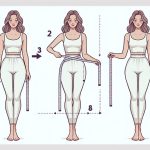When it comes to measuring the hips of men, it's like traversing a complex labyrinth in search of a hidden treasure.
I've discovered that understanding the intricacies of hip measurements can reveal a world of perfectly tailored clothing and enhanced comfort.
Let's explore the tools, techniques, and insights that can lead us to this sartorial treasure trove, ensuring that every man can confidently stride in pants that fit like a glove.
Table of Contents
Key Takeaways
- Use a flexible measuring tape for accurate hip measurements.
- Stand straight and locate the widest part of your buttocks.
- Wrap the tape parallel to the floor and check snugness.
- Avoid bulky clothing, ensure consistent tape placement for precise results.
Importance of Hip Measurements
Understanding the significance of hip measurements can provide valuable insights into one's overall health and fitness level. When it comes to clothing styles, having accurate hip measurements guarantees that clothes fit properly and flatter your body shape. Ill-fitting clothes can't only be uncomfortable but also impact your confidence. By knowing your hip size, you can confidently choose outfits that enhance your appearance and make you feel great.
Additionally, hip measurements play an important role in tracking progress towards fitness goals. As we engage in exercise and adopt healthy lifestyle habits, our bodies change. Monitoring changes in hip size can indicate whether we're losing fat, gaining muscle, or achieving a more balanced physique. It serves as a tangible way to measure the effectiveness of our fitness routines and diet choices. Whether your goal is to slim down, build muscle, or improve overall health, keeping track of your hip measurements is a helpful tool in evaluating your progress and staying motivated.
Tools Needed for Measuring
To accurately measure your hip size, all you need is a flexible measuring tape and a mirror to confirm precise readings. These measuring tools are essential for obtaining accurate results. The measuring tape should be flexible to easily wrap around your hips without affecting the measurement. A mirror can be helpful to make sure that the tape is straight and level around your hips, avoiding any errors in the readings.
When using the measuring tape, it's important to follow the correct technique to get the most accurate hip measurement. Start by standing up straight with your feet together. Place the measuring tape around the fullest part of your hips, usually around the buttocks and hip bones. Make sure the tape is snug but not too tight against your skin. Take the measurement without holding your breath or sucking in your stomach to get the most precise reading.
Step-by-Step Guide
When measuring your hip size as a man, make sure you have a flexible measuring tape and a mirror for accuracy. Here's a step-by-step guide to help you measure your hips correctly:
- Stand Straight: Ensure you're standing up straight with your feet together.
- Locate the Hips: Find the widest part of your buttocks to measure your hip circumference accurately.
- Wrap the Tape: Gently wrap the measuring tape around your hips, keeping it parallel to the floor.
- Check the Measurement: Look in the mirror or have a friend assist you to make sure the tape is snug but not too tight.
- Record the Measurement: Note down the measurement in inches or centimeters for future reference.
For individuals with an athletic build, accurately measuring your hips is important for understanding your body composition. By following these simple steps, you can make sure that you have the correct hip measurements to track changes in your body over time.
Common Mistakes to Avoid
When measuring hip size, it's important to make sure you're using the right technique and tools. Incorrect measuring methods can lead to inaccurate results, affecting the fit of your clothing.
To get the most precise measurement, pay attention to the details and avoid these common mistakes.
Proper Measuring Technique
While measuring your hip size, it's important to make sure you avoid common mistakes that can impact the accuracy of your measurements. Here are some key points to consider:
- Consistent Placement: Make sure the measuring tape is parallel to the floor and placed around the widest part of your hips.
- Proper Tension: Don't pull the tape too tight or too loose; maintain a snug but comfortable fit.
- Standing Straight: Stand up straight with your feet together to get an accurate measurement.
- Avoid Bulky Clothing: Wear form-fitting clothes or measure over thin layers to prevent inaccuracies.
- Double-Check: Measure a few times to make sure consistency and accuracy in your hip size comparison.
These tips will help you get precise measurements for better clothing fit correlation and body shape analysis.
Choosing Correct Measuring Tools
To guarantee accurate measurements for your hip size, selecting the right measuring tools is essential for obtaining precise results. Using a flexible measuring tape is vital for accurately determining your hip circumference. Avoid using rigid tools like rulers, as they may not conform to your body's curves, leading to inaccurate measurements.
Additionally, refer to sizing charts provided by clothing brands to make sure your measurements align with their sizing standards. Incorrect measurements can result in ill-fitting clothing, causing discomfort and style issues.
Understanding Hip-to-Waist Ratio
Understanding the Hip-to-Waist Ratio provides valuable insight into one's overall health and body composition. When it comes to measuring hip size for men, this ratio is an essential indicator that can help you track your progress towards your fitness goals. Here are five key points to take into account:
- Body Composition: The hip-to-waist ratio is a simple yet effective way to assess your body composition and determine how much fat is distributed around your hips and waist.
- Health Indicator: A higher ratio is often associated with increased health risks, including cardiovascular issues and metabolic disorders.
- Fitness Progress: Monitoring changes in your hip-to-waist ratio over time can help you evaluate the effectiveness of your workout routine and diet plan.
- Clothing Fit: Understanding your hip-to-waist ratio can guide you in choosing clothing that fits well and complements your body shape.
- Motivation: Seeing improvements in your hip-to-waist ratio can be a motivating factor to stay committed to your fitness journey.
Tips for Accurate Measurements
For precise measurements of your hip size, it's important to follow these simple yet effective tips. When measuring your hips, it's essential to wear form-fitting clothing that sits comfortably on your body. Avoid wearing bulky or oversized garments as they can alter the accuracy of your measurements.
Make sure the tape measure is snug against your skin but not too tight, allowing for a natural hip shape. To get the most accurate reading, measure around the fullest part of your hips, typically around the hip bone. It's important to stand up straight and keep your feet together during the measurement process to maintain consistency.
Understanding clothing sizing and body proportions is key in interpreting your measurements accurately. By following these tips, you can confidently measure your hip size and use this information to select well-fitting clothing that complements your body shape.
Interpreting Your Measurements
Let's explore into making sense of your measurements. After taking your hip measurements accurately, it's time to interpret the results to make sure you aim for the ideal fit.
Here are some key points to take into account:
- Comparing with Size Charts: Check size charts provided by clothing brands to match your measurements with the recommended sizes. This will guide you towards the best-fitting garments.
- Understanding Variations: Recognize that different brands may have slight variations in sizing, so don't be discouraged if your measurements fall between sizes.
- Considering Fabric Stretch: Take into account the fabric's stretchiness when interpreting results. A stretchy fabric might allow for a snugger fit even if the measurements slightly differ.
- Feedback and Reviews: Look for feedback from other customers or reviews online. They can provide insights into whether a specific garment runs true to size or runs small/big.
- Adjusting for Preference: Remember that ideal fit can also be subjective. Some prefer a looser fit, while others prefer a more tailored look. Make adjustments based on your personal style and comfort preference.
Shopping for the Perfect Fit
After interpreting your hip measurements, now it's time to find the perfect fit while shopping for clothing. When it comes to size selection, always refer to the brand's specific sizing charts to guarantee the best fit. Additionally, keep these fitting tips in mind: opt for slim fits if you prefer a more tailored look, choose straight cuts for a classic style, and experiment with relaxed fits for a casual vibe.
| Size Selection | Fitting Tips | Finding the Right Style |
|---|---|---|
| Refer to sizing charts for accuracy | Opt for slim fits for a tailored look | Experiment with different styles |
| Take accurate measurements | Choose straight cuts for a classic style | Consider tailoring options |
| Don't hesitate to try different sizes | Consider relaxed fits for a casual vibe | Match your style to the occasion |
When shopping, focus on finding the right style that complements your body shape and personal preferences. Don't be afraid to explore tailoring options to achieve the perfect fit if needed.
Adjusting Patterns for Custom Fit
When adjusting patterns for a custom fit, it's crucial to understand pattern alterations, custom tailoring tips, and hip measurement adjustments.
These points will help tailor clothing to your unique body shape and size, ensuring a comfortable and stylish fit.
Pattern Alterations for Fit
To achieve a custom fit, one can make pattern alterations that cater to individual body measurements and preferences. When it comes to pattern alterations for fit, there are several key adjustments to contemplate:
- Grading between sizes: Gradually increasing or decreasing the pattern size in different areas for a more precise fit.
- Lengthening or shortening: Adjusting the pattern to accommodate variations in torso or limb length.
- Adding or removing ease: Tailoring the garment to have more or less room based on personal comfort.
- Altering darts or seams: Customizing the shaping of the garment to suit specific body contours.
- Adjusting shoulder width or slope: Modifying the pattern to align with individual shoulder measurements for improved comfort and fit.
Custom Tailoring Tips
Making pattern alterations is like tailoring a garment to fit me perfectly; it's all about adjusting the measurements to suit my individual body shape and style preferences. When custom tailoring, consider styling tips and current fashion trends to make sure your garment is not only well-fitted but also stylish. Here are some key tips for adjusting patterns:
| Custom Tailoring Tips | |
|---|---|
| 1. Take Accurate Measurements | 2. Use Muslin for Mock-ups |
| 3. Make Small Adjustments | 4. Consider Ease for Movement |
| 5. Test Fit Along the Way |
Hip Measurement Adjustments
Adjusting patterns for a custom fit involves carefully considering hip measurement adjustments to guarantee the garment fits comfortably and flatters your unique body shape. When dealing with hip size variations and fitting issues, here are five key adjustments to enhance your garment:
- Grading: Increase or decrease hip width while maintaining proportions.
- Dart Placement: Adjust dart positions for a tailored fit.
- Adding Ease: Incorporate ease for movement and comfort.
- Full Hip Adjustment: Modify patterns to accommodate wider hips.
- Style Modifications: Tailor the design to match your style preferences.
Frequently Asked Questions
Can Hip Measurements Be Used to Determine Overall Health and Fitness Levels in Men?
Hip measurements can provide insights into body composition and health. When combined with waist measurements, the waist-to-hip ratio can be a useful indicator of fitness levels. Monitoring these measurements can help gauge overall health and wellness.
How Often Should Men Re-Measure Their Hips to Ensure Accurate Sizing for Clothing?
I re-measure my hips yearly to guarantee accurate clothing sizes. Fashion trends may change, and weight gain can impact body changes. Regular measurements help me stay stylish and comfortable in my clothes.
Are There Specific Exercises or Stretches That Can Help Improve Hip Measurements in Men?
Improving hip flexibility and strength through targeted exercises like hip flexor stretches and squats can positively impact body measurements. These exercises not only benefit health but also align with modern fashion trends and promote positive body image.
Can Hip Measurements Affect Posture and Back Pain in Men?
Hip ratios play an important role in posture and can impact back pain. Maintaining proper hip measurements through exercises and stretches can improve posture, reducing strain on the back and potentially alleviating discomfort.
Are There Any Cultural or Societal Factors That May Influence the Ideal Hip Measurements for Men?
Cultural influences and societal norms play significant roles in shaping the ideal hip measurements for men. Body image ideals, fashion trends, and historical perspectives all contribute to defining what is considered attractive or desirable regarding hip size.
- Tetron Fabric for Marine Applications: Durability and Use Cases - June 18, 2025
- Tetron Fabric for Outdoor Furniture: Weather Resistance and Care - June 18, 2025
- Tetron Fabric for Wall Coverings: Style and Application Tips - June 18, 2025




